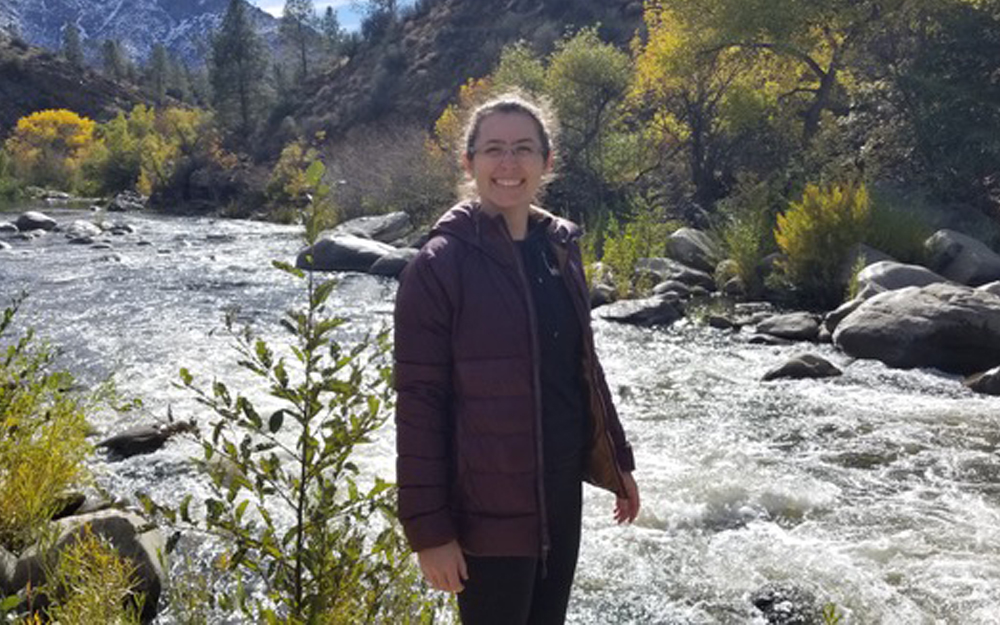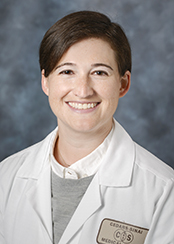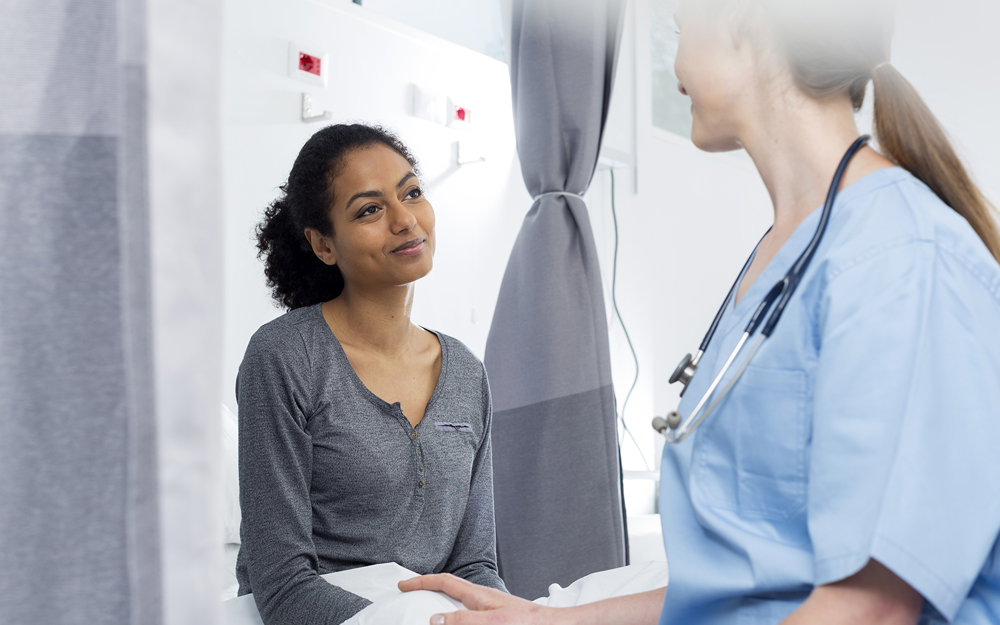You're Not Alone: Coping With Endometriosis
Date
July 10, 2023
Credits

Date
July 10, 2023
Credits
Medical providers featured in this article

In Brief
{{cta-block}}
When Sarah Stockman’s first period, at 12 years old, included two weeks of heavy bleeding, her doctors reassured her that it was normal and her hormones were just adjusting to puberty.
But by 15, the Los Angeles native started feeling sharp pelvic pain as large cysts in her ovaries ruptured. She visited an OB-GYN, who saw her as an “emotionally fragile teenager” and suggested she go to a therapist. They also prescribed birth control to block ovulation, the usual culprit of ovarian cysts. Although it didn’t help right away, the oral pill kept her pain at bay long enough for Stockman to move to Maryland and pursue a pre-med track at Johns Hopkins University.
In the fall of her senior year of college, severe cramping returned. This time, it was excruciating—and getting worse. Stockman cycled through nine doctors in seven months, but none knew what to make of it. She ended up doubled over in agony, crying on her shower floor.
After graduation, she moved back home and thought, “I'm going to have to live here forever, with my parents taking care of me.”
“People with endometriosis are probably the best actors in Los Angeles, because we have to fake it all the time.”
Instead, she found a Cedars-Sinai doctor, who performed an exploratory laparoscopy. The doctor looked inside of Stockman’s abdomen and pelvic organs with a camera—and finally found the missing puzzle piece.
She had adenomyosis and endometriosis, painful sister conditions that happen when tissue similar to the uterine lining (endometrium) grows elsewhere. The tissues implant either outside the uterus—such as in the fallopian tubes, ovaries, bowel or bladder—or within the uterine muscle itself (adenomyosis). The tissues respond to menstrual cycle hormones, triggering inflammation and scarring.
Endometriosis affects more than 6.5 million women in the U.S., or around 11%, according to the U.S. Department of Health and Human Services’ Office on Women’s Health. The reproductive illness takes a heavy toll on quality of life, causing chronic pelvic pain, benign tumors, adhesions that stick organs together, and heavy periods that can force sufferers to regularly miss work (and wages), school or socializing.
Many patients also struggle with urination and bowel movements, painful sex, fatigue, digestive symptoms such as nausea, mental health, and trouble getting pregnant, with endometriosis doubling the risk of infertility.
Long Road to Diagnosis
Often, women suffer in silence for years. The average diagnosis takes about 10 years, experts estimate.
“In that 10-year span are lots of doctors, feelings of being dismissed, and not knowing what to say or how to manage the system to get what they need,” said Caryn Lindsey, a Cedars-Sinai social worker who leads the Endometriosis Peer Support Network.
After living with painful periods since age 14, Jill Panaro was diagnosed with endometriosis in her hometown of Boston when she was 21. Her periods left her nauseous, sweating and dizzy—unable to even sit down on a bike, despite playing on her college soccer team.
Her merry-go-round of doctors—who blamed the problem first on gastrointestinal upset and then on kidney stones—made Panaro feel completely alone and frustrated. Some talked down to her, ignored her or wouldn’t explain her condition.
“Eventually you think, ‘Am I crazy? Am I really not in this amount of pain? Because no one’s believing me,’” Panaro said.
In the Newsroom: Endometriosis Awareness Month: One Woman’s Long Journey to Wellness
Medical gaslighting can keep women in the dark about their own bodies and make them think they’re broken, an impression Lindsey said commonly follows patients well into adulthood.
“Having debilitating periods that keep you from everyday life is not normal,” explained Kelly Wright, MD, associate professor of Obstetrics and Gynecology and division director of Minimally Invasive Gynecologic Surgery at Cedars-Sinai. “Find a doctor who takes it seriously. And if your doctor doesn't, get a second opinion, because we don't want you to face a lifetime of pain nobody’s dealt with, resulting in worse problems.”
Diagnosing endometriosis is also medically challenging, she added, because blood tests don’t exist, and different types of endometriosis aren’t always visible using existing imaging options. Furthermore, the disease is poorly understood and understudied, with little funding.
“Just keep going,” Panaro encourages other patients. “You’re not alone.”
{{providers}}
Need for Support
Emotional support is crucial to coping with the anxiety, stress, loneliness and pain of endometriosis.
In August 2022, Lindsey launched Cedars-Sinai’s Endometriosis Peer Support Network, which has already assisted nearly 40 endometriosis patients. The program is designed to provide social support and help women navigate relationships and areas of life impacted by the diagnosis (as well as overwhelming treatment options, financial implications and healthcare system complexity). It connects patients directly with volunteers who have had their own extensive endometriosis journeys and understand. Those who are interested in joining the group can get more information by reaching out to Lindsey or calling her at 310-423-2412.
The network is also seeking more peer volunteers who have lived with endometriosis. Both Stockman and Panaro volunteer, hoping to share the guidance they wish they’d had on their journeys.
In the more than two decades since her diagnosis—and after one West Coast move—Panaro endured chronic pain in her muscles and eventually became incontinent. She wanted a hysterectomy early on, but doctors repeatedly brushed off her requests, suggesting she could change her mind and want children one day or that pregnancy might even help her symptoms.

As a self-employed sports massage therapist, she strained at times to meet the job’s highly physical demands, missing appointments. She constantly had to cancel plans with friends for concerts, sports games and even trips because she was too sick.
She mostly stayed quiet about what was really going on to avoid having to explain the condition and because of taboos around talking about women’s reproductive health.
“People with endometriosis are probably the best actors in Los Angeles, because we have to fake it all the time,” she said.
A best friend stood in the gap for Panaro, driving her to all her appointments, advocating for her and listening without requiring her to censor herself.
“If you have a broken arm and are wearing a sling, people know you’re hurt and are more careful around you or ask if you’re OK,” Lindsey said. “When you’re having endometrial pain, people can’t see it.”
Stockman’s endometriosis deteriorated, causing her so much pain that, by 2019, she had to lay in bed with a heating pad every day and hold off on bathroom trips for hours. She stopped talking to certain friends, because it took too much effort.
“It’s like a full-time job to manage that much pain,” Stockman explained.
Her parents and loved ones were supportive, but the condition built a wall between them as she tried to protect them from the truth.
Stockman sought out a therapist, who helped her manage the pain and come to her toughest decision yet: having hysterectomy to remove her uterus at age 27.
“Because endometriosis primarily affects the reproductive system, for many women, it immediately challenges their identity,” Lindsey pointed out. “That can be incredibly isolating and confusing.”
In Discoveries: The Unfair Sex
The Right Medical Care
There isn’t a cure or one-size-fits-all treatment, according to experts. Building a care team that allows you to make the right choices for yourself is the best strategy.
“Those of us going through this have experienced some level of pain and been hyperaware of what’s happening in our bodies for a really long time,” Stockman said. “We’re experts on ourselves.”
Gynecologists treat endometriosis differently depending on each patient’s age, fertility goals, and the depth and magnitude of endometrial implants, connected organs and cysts . Early on, hormone-based medications may slow the disease or control symptoms related to menstruation. Some medications called GnRH agonists or antagonists may also control the disease, but they work by blocking hormone production and can only be used for short periods of time.
Wright explained that as the disease advances, surgeons often need to remove implants, which can help ease inflammation and related pain—an important treatment component. Surgery can also clear organ damage from adhesions, like Panaro’s urologic and fecal control.
When endometriosis irritates surrounding nerves and muscles, physical therapy is recommended, alongside anti-inflammatory or nerve-blocking medications, such as vaginal Botox injections, for pain. Physical therapy, which involves stretches and massages to strengthen the pelvic floor, was uncomfortable, but a game-changer for both women.
Many patients with severe disease also end up needing hysterectomies, a choice Wright admitted can come with baggage but is very different than it used to be. Today’s version is minimally invasive and preserves ovaries, so patients keep their hormones and nerves.
Stockman went in for her hysterectomy in 2022 with pain that she rated an 11 out of 10 and left at a 3, improving even more in the year since.
“A doctor told me once that being a woman is painful,” she said. “And that's very wrong.”
Learn more about the Endometriosis Program at Cedars-Sinai.





